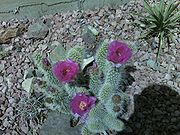
Xeriscaping
Encyclopedia

Garden design
Garden design is the art and process of designing and creating plans for layout and planting of gardens and landscapes. Garden design may be done by the garden owner themselves, or by professionals of varying levels of experience and expertise...
and gardening
Gardening
Gardening is the practice of growing and cultivating plants. Ornamental plants are normally grown for their flowers, foliage, or overall appearance; useful plants are grown for consumption , for their dyes, or for medicinal or cosmetic use...
in ways that reduce or eliminate the need for supplemental water from irrigation
Irrigation
Irrigation may be defined as the science of artificial application of water to the land or soil. It is used to assist in the growing of agricultural crops, maintenance of landscapes, and revegetation of disturbed soils in dry areas and during periods of inadequate rainfall...
. It is promoted in regions that do not have easily accessible, plentiful, or reliable supplies of fresh water
Fresh Water
Fresh Water is the debut album by Australian rock and blues singer Alison McCallum, released in 1972. Rare for an Australian artist at the time, it came in a gatefold sleeve...
, and is gaining acceptance in other areas as climate patterns shift
Global warming
Global warming refers to the rising average temperature of Earth's atmosphere and oceans and its projected continuation. In the last 100 years, Earth's average surface temperature increased by about with about two thirds of the increase occurring over just the last three decades...
.
Term history
The word xeriscaping is a portmanteau of xeros ξήρος (Greek for "dry") and landscapingLandscaping
Landscaping refers to any activity that modifies the visible features of an area of land, including:# living elements, such as flora or fauna; or what is commonly referred to as gardening, the art and craft of growing plants with a goal of creating a beautiful environment within the landscape.#...
, and xeriscape is used for this style of garden. Xeriscaping refers to a method of landscape design that minimizes water use.
Many Denver Water employees helped coin the term xeriscape, and Xeriscape and the xeriscape logo are registered trademarks of Denver Water, the water department of Denver
Denver, Colorado
The City and County of Denver is the capital and the most populous city of the U.S. state of Colorado. Denver is a consolidated city-county, located in the South Platte River Valley on the western edge of the High Plains just east of the Front Range of the Rocky Mountains...
, Colorado
Colorado
Colorado is a U.S. state that encompasses much of the Rocky Mountains as well as the northeastern portion of the Colorado Plateau and the western edge of the Great Plains...
.
In some areas, terms such as water-conserving landscapes, drought-tolerant landscaping, zeroscaping, and smart scaping are used instead. Plants whose natural requirements are appropriate to the local climate are emphasized, and care is taken to avoid losing water to evaporation and run-off. The specific plants used in xeriscaping depend upon the climate.
Xeriscape Advantages

- Lowers consumption of imported or ground water.
- More water available for other domestic and community uses and the environment.
- Less time and work needed for maintenance effort, with gardening simpler and less stressful.
- Little or no lawnmowing
- Xeriscape plants in appropriate planting design, and soil grading and mulching, takes full advantage of rainfall retention.
- When water restrictions are implemented, by municipality or water costs, xeriscape plants will tend to survive and thrive, while more ornamental plants may be unable to adapt.
Xeriscape at Botanic Gardens
The world's first Xeriscape Demonstration Garden (now named Dryland Mesa) was created at the Denver Botanic GardensDenver Botanic Gardens
The Denver Botanic Gardens is a public botanical garden located in Denver, Colorado in the Cheesman Park neighborhood. The park contains a conservatory, a variety of theme gardens and a sunken amphitheater, which hosts various concerts in the summer...
in 1986. Its design was based on the "Seven Principles" of Xeriscape.
The Sonora Desert Museum holds an annual Xeriscape contest. The Special Awards presented include The J.D. Di Meglio Artistry In Landscaping Award (unique beauty in Xeriscape landscaping) and The Community Xeriscape Leader Award ("a driving force in promoting Xeriscape principles and/or the use of native and arid-adapted plants").
X-Ratings
In 1982 the Denver water Department's Xeriscape Demonstration Garden was dedicated with an "X-rated party". The X stood for Xeriscape, but the humor was intended. Garden centers continued with a system of X-ratings, from X to XXX, to specify how much water individual types of plants need.The Seven Principles of Xeriscape
The Xeriscape concept is based on The Seven Principles:1. Plan and design
Create a diagram, drawn to scale, that shows the major elements of your landscape, including house, driveway, sidewalk, deck or patio, existing trees and other elements.
Once you've completed a base plan of an existing site, think about how you want to use your new Xeriscape. Do you want it to be a place for dogs to run? Curb appeal? Frame or screen views? Create a conceptual plan (bubble diagram) that shows the areas for turf, perennial beds, views, screens, slopes, etc. Once finished, develop a planting plan that reinforces the areas in the appropriate scale.
2. Soil amendment
Most plants will benefit from the use of compost, which will help the soil retain water. Some desert plants prefer gravel soils instead of well-amended soils. Plants should either fit the soil or soil should be amended to fit the plants.
3. Efficient irrigation
Xeriscape can be irrigated efficiently by hand or with an automatic sprinkler system. Zone turf areas separately from other plants and use the irrigation method that waters the plants in each area most efficiently. For grass, use gear-driven rotors or rotary spray nozzles that have larger droplets and low angles to avoid wind drift. Spray, drip line or bubbler emitters are most efficient for watering trees, shrubs, flowers and groundcovers.
If you water by hand, avoid oscillating sprinklers and other sprinklers that throw water high in the air or release a fine mist. The most efficient sprinklers release big drops close to the ground.
Water deeply and infrequently to develop deep roots. Never water during the day to reduce water lost to evaporation. If you have an automatic sprinkling system, adjust your controller monthly to accommodate weather conditions. Also, install a rain sensor to shut off the device when it rains.
4. Appropriate plant and zone selection
Different areas in your yard receive different amounts of light, wind and moisture. To minimize water waste, group together plants with similar light and water requirements, and place them in an area that matches these requirements. Put moderate-water-use plants in low-lying drainage areas, near downspouts, or in the shade of other plants. Your turf will require the most water and shrub/perennial beds will require approximately half the amount of water.
Dry, sunny areas support low-water-use plants that grow well in our climate. Planting a variety of plants with different heights, color and textures creates interest and beauty.
5. Mulch
Mulch keeps plant roots cool, prevents soil from crusting, minimizes evaporation and reduces weed growth. Organic mulches, such as bark chips, pole peelings or wood grindings, should be applied 2 to 4 inches deep. Fiber mulches create a web that is more resistant to wind and rain washout. Inorganic mulches, such as rocks and gravel, should be applied 2 to 3 inches deep. Surrounding plants with rock makes the area hotter; limit this practice.
6. Alternative turf
Native grasses (warm-season) that have been cultivated for turf lawns, such as buffalo grass and blue grama, can survive with a quarter of the water that bluegrass varieties need. Warm-season grasses are greenest in June through September and straw brown the rest of the year.
Native grasses (cool season) such as bluegrass and tall fescue, are greenest in the spring and fall and go dormant in the high heat of the summer. New cultivars of bluegrass, such as Reveille, and tall fescue, can reduce typical bluegrass water requirements by at least 30 percent. Fine fescues can provide substantial water savings and is best used in areas that receive low traffic or are in shady locations.
Use the appropriate grass and limit the amount of grass to reduce the watering and maintenance requirements.
7. Maintenance
All landscapes require some degree of care during the year. Turf requires spring and fall aeration along with regular fertilization every 6 to 8 weeks. Keep your grass height at 3 inches and allow the clippings to fall. Trees, shrubs and perennials will need occasional pruning to remove dead stems, promote blooming or control height and spread. Much of the removed plant material can be shredded and used in composting piles.
See also
- Sustainable gardeningSustainable gardeningSustainable gardening comprises a disparate group of horticultural interests that share, to a greater or lesser extent, the aims and objectives associated with the international post-1980s sustainable development and sustainability programs...
- Natural landscapingNatural landscaping.Natural landscaping, also called native gardening, is the use of native plants, including trees, shrubs, groundcover, and grasses which are indigenous to the geographic area of the garden.-Maintenance:...
- Sustainable landscape architectureSustainable landscape architectureSustainable landscape architecture is a category of sustainable design concerned with the planning and design of outdoor space.This can include ecological, social and economic aspects of sustainability...
- Wildlife garden
- Native plantNative plantNative plant is a term to describe plants endemic or naturalized to a given area in geologic time.This includes plants that have developed, occur naturally, or existed for many years in an area...
- Rainwater harvestingRainwater harvestingRainwater harvesting is the accumulating and storing of rainwater for reuse before it reaches the aquifer. It has been used to provide drinking water, water for livestock, water for irrigation, as well as other typical uses. Rainwater collected from the roofs of houses and local institutions can...
- GardeningGardeningGardening is the practice of growing and cultivating plants. Ornamental plants are normally grown for their flowers, foliage, or overall appearance; useful plants are grown for consumption , for their dyes, or for medicinal or cosmetic use...
- Sustainable farming
- Dryland farmingDryland farmingDryland farming is an agricultural technique for non-irrigated cultivation of drylands.-Locations:Dryland farming is used in the Great Plains, the Palouse plateau of Eastern Washington, and other arid regions of North America, the Middle East and in other grain growing regions such as the steppes...
- International Center for Agricultural Research in the Dry AreasInternational Center for Agricultural Research in the Dry AreasInternational Center for Agricultural Research in the Dry Areas is an Arab center for International Agricultural Research located at Tel Hadya near Aleppo in the Syrian Arab Republic....
External links
- Xeriscape Landscaping
- Drought Smart Plants
- Back to Natives Restoration a 501(c)3 (Irvine, CaliforniaIrvine, CaliforniaIrvine is a suburban incorporated city in Orange County, California, United States. It is a planned city, mainly developed by the Irvine Company since the 1960s. Formally incorporated on December 28, 1971, the city has a population of 212,375 as of the 2010 census. However, the California...
) - American Water Works Association
- H2ouse
- Center for the Study of the Built Environment's Water-Conserving Landscapes Project

